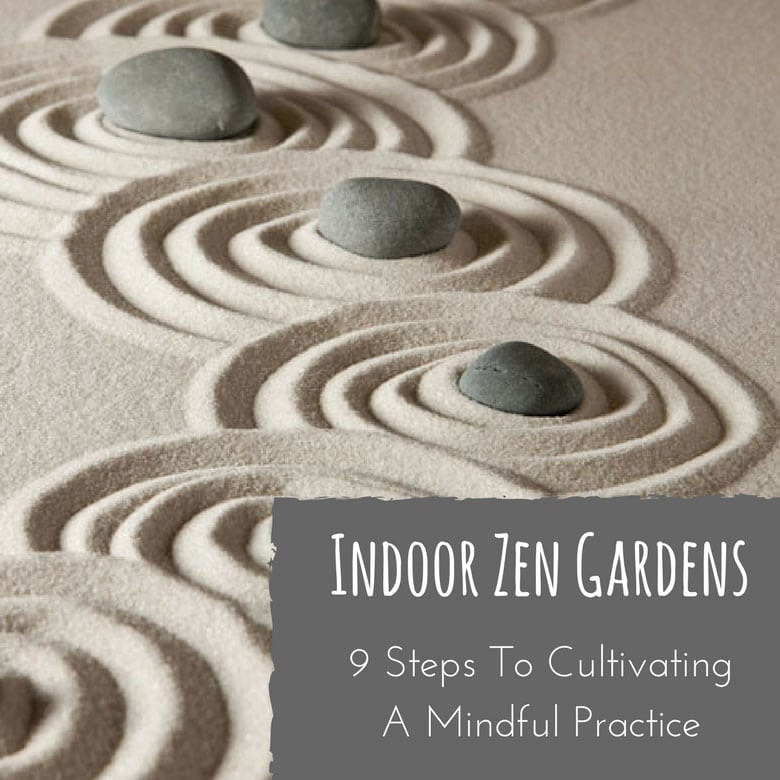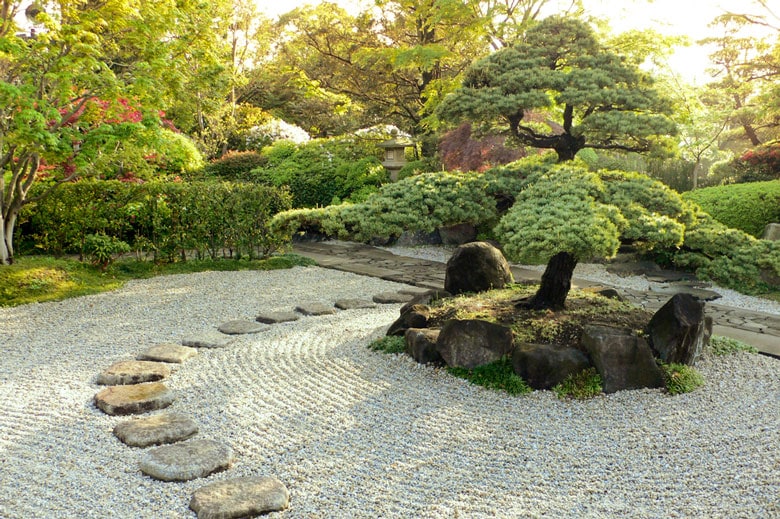Zen gardens have been used for thousands of years.
These Japanese inspired designs are not only landscaping masterpieces, but also objects of meditative contemplation.
Indoor Zen gardens are a simple and creative way to cultivate mindful practice inside.
Much smaller than traditional outdoor varieties, you can use them conveniently at home or in the office.
They are easy to use, simple to maintain, and fun to design.
Better yet, they are a great way to cultivate mindfulness!
Indoor Zen gardens
Despite their small size, indoor Zen gardens maintain many of the traditional aspects of the outdoor Japanese rock gardens after which they are modelled.
Designs are stylized based on the Buddhist tradition of simplicity.
Common elements incorporated into Zen gardens (both indoor and outdoor varieties) include carefully selected stones or rocks, sand, moss, shrubs, small trees, and running water.
Despite their obvious difference in size, at the very essence, both indoor and outdoor Zen gardens invoke the feeling of nature.
The origin of Zen gardens
There are many kinds of Zen gardens, some of which date back thousands of years.
The Ryōan-ji Temple in Japan for example is home to one of the most preserved kare-sansui or dry landscape style Zen rock gardens from the 15th century.
These gardens are artistic creations that have been used traditionally as vehicles for contemplation, self-reflection, and beautification.
True to the essence of Zen, Japanese gardens inspire mindful meditative practice through their simplistic graceful design.
In the words of Shunmyo Masuno, Japan’s leading garden designer, “In Japanese culture, rather than emphasizing the form of something itself, more importance is placed on the feeling of the invisible things that come with it: restrained elegance, delicate beauty, elegant simplicity and rusticity”.
Like the Buddhist tradition from which they emerged, the gardens reflect discipline, and require care and maintenance.
It’s believed that in these sacred spaces, the gardener and nature become one, and through this, you can witness the “fusion of nature and art”.
Modern science’s take on Zen gardens
It’s believed by some professionals that the appeal of these Zen gardens is due to the tree-like fractals present in their design.
Fractals are geometric forms that are visible as tiny patterns that repeat themselves in such a manner that they appear collectively to resemble their larger form.
Fractals in nature can be seen in snowflakes or branch patterns in trees. (Each snowflake is composed of many micro-snowflakes arranged in the same form as the big one they together create).
Looking at fractals is also found to be of therapeutic value as it is known to reduce stress and promote relaxation.
How to use an indoor Zen garden:
1. Choose a prominent location
Place your indoor Zen garden in a prominent location where it can be easily seen but not in the way where it can get bumped. (Sand is no fun to clean up!)
2. Calm your mind
Before you attempt to start arranging the stones or raking the sand, take a moment to quiet your mind and draw your attention to your breathing.
3. Rearrange the stones or pebbles
When you have found yourself in a calm meditative headspace, begin to rearrange the pebbles. Take note of the feeling and texture of the stones surface, as well as any blemishes or impurities of the stone. Always position rocks in a manner that the the best side is facing forward.
4. Draw patterns in the sand
Once you’re pleased with the layout of the stones, choose either a rake or a thin tool (like the back of a paintbrush) to begin tracing simple deliberate lines in the sand. This process should be done mindfully, using the slow drawing motion to bring your focus back to the present moment. Most often, the patterns in the sand are done in such a manner that they appear to resemble water features like waves or gentle ripples.
5. Enjoy the quiet
While active in your Zen garden practice, try to limit outside distractions. Cultivate silence in your physical environment and stillness in your mind. If you’re doing this activity at work and it isn’t possible to block out all noise, consider listening to meditation music to help keep your attention on your practice.
6. Slow down
Zen gardens are meant to mirror elements in the natural world. Because of this, their creation should be done slowly and deliberately. Nature does not rush, and neither should you!
7. Reflect on the simplicity
Nearing the end of your practice, step back and admire your work. Take note of the beauty in its simplicity and the artistic expression of your creation. Notice the textures, angles, and positioning of each element.
8. Rake away the design
After taking a few moments to enjoy your creation, gently wipe away the design and return the stones to the side of the garden. Raking over the design helps you become aware of the impermanence of life and that each moment is sacred. It also encourages you not to become attached, to material items, states of being, or even this moment. It too shall pass!
9. Return to your garden
Essential to the practice of Zen is self-discipline. Establish a daily ritual that involves spending a few minutes with your indoor garden. Allow the full benefits of its simplicity, therapy, and ancient wisdom inspire wellness and become part of your regular mindful practice.
Whether at home or in the office, indoor Zen gardens offer you an artistic way to experience mindfulness and the beauty of nature’s simplicity.
Things to keep in mind with Zen gardens
Simplicity is key in all Zen garden designs.
Whether you choose a dry sand garden or a planted herbaceous one with live elements, the general rule of thumb is less is more.
There is no wrong way to use your Zen garden, but to not use it at all!
Keep in mind, you aren’t being graded on your design. Everything you do will soon be wiped away, so you can start over and repeat the process.
Don’t worry on creating a beautiful end product. It’s the process that matters for this practice, not the symmetry of your rocks or Picasso-like reflections in the sand.
Be creative, and allow this simple exercise to inspire your mindful practice.


